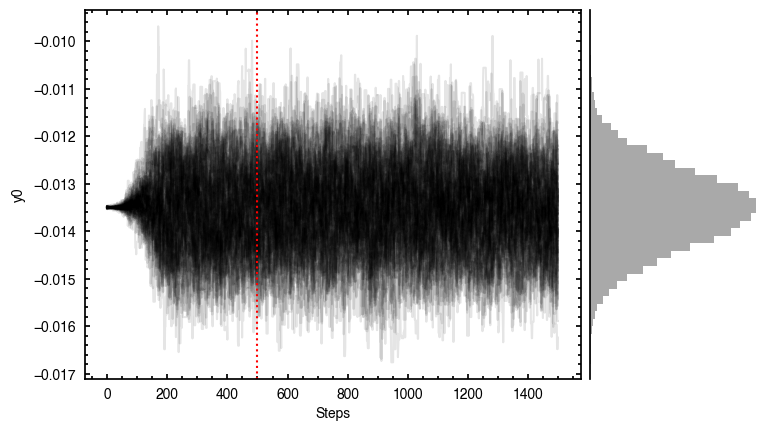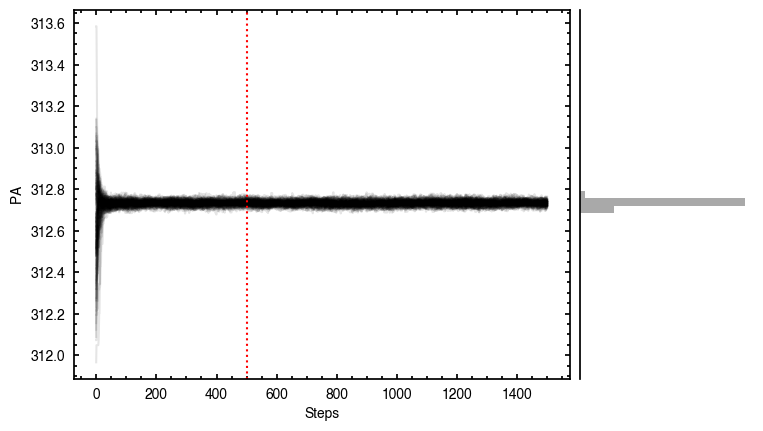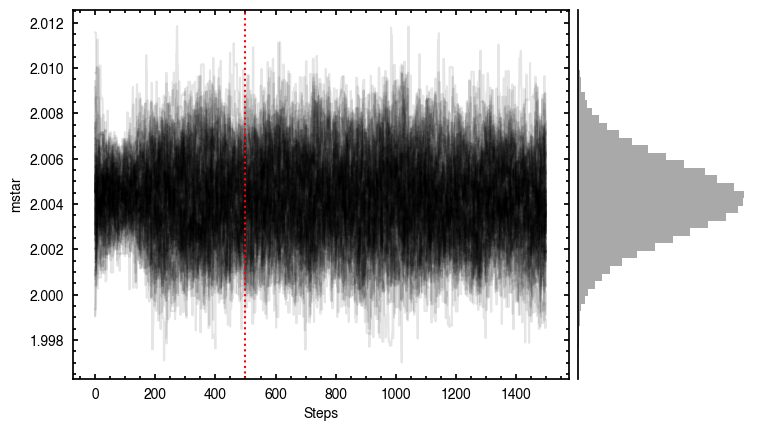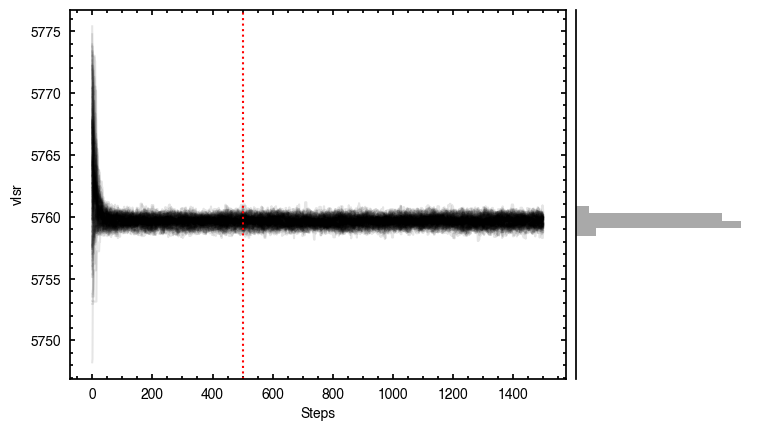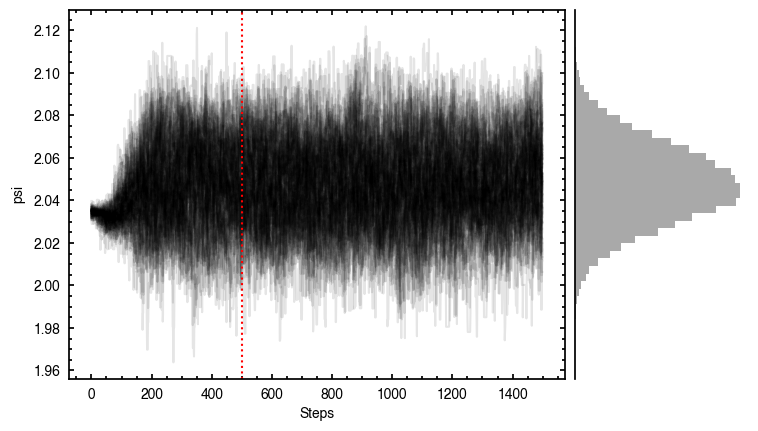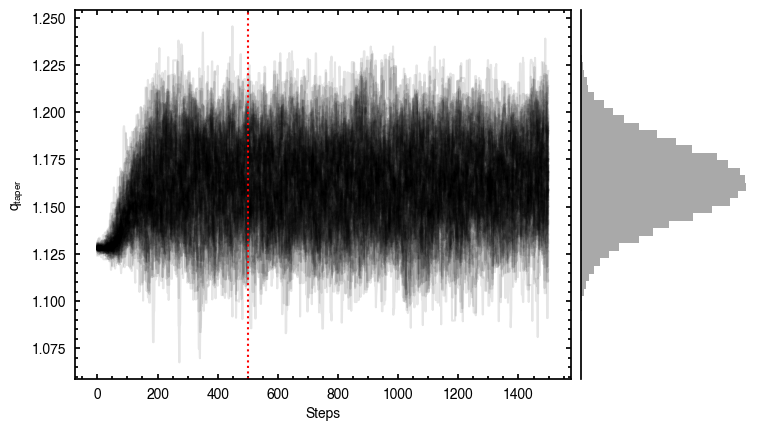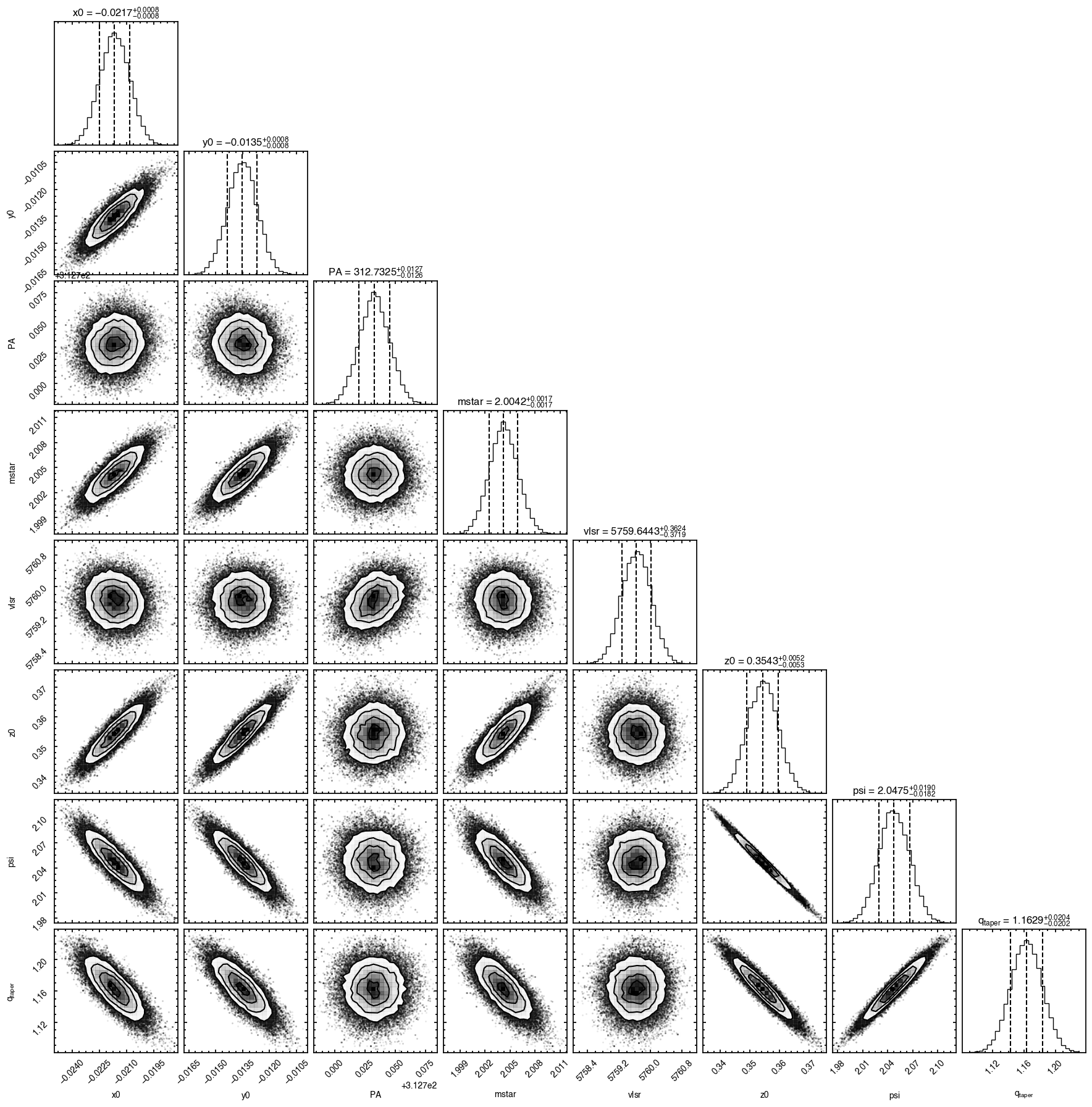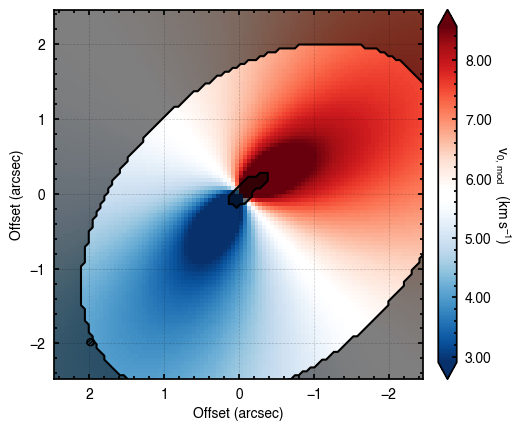2 - Disks with Elevated Emission Surfaces¶
This Notebook deals with disks where the vertical structure can clearly be resolved. This is fairly common now that ALMA observations of bright  emission are routinely achieving angular resolutions of a few hundreds of milliarcseconds.
emission are routinely achieving angular resolutions of a few hundreds of milliarcseconds.
[1]:
from multiprocessing import Pool
import matplotlib.pyplot as plt
from eddy import rotationmap
HD 163296 - A Geometrically Thick Disk¶
For this tutorial we will look at the disk around HD 163296. We’ll use data from the DSHARP project, with the data described in Isella et al. (2018) and available here. There are many different ways of collapsing a cube to a velocity map and with various different programs. For now, we’ll use ones collapsed using bettermoments and are available from the eddy Dataverse.
We can directly download the data if you don’t already have it.
[2]:
import os
if not os.path.exists('HD163296_CO_v0.fits'):
!wget -O HD163296_CO_v0.fits -q https://dataverse.harvard.edu/api/access/datafile/:persistentId?persistentId=doi:10.7910/DVN/C2ZUNO/AWCSZR
if not os.path.exists('HD163296_CO_dv0.fits'):
!wget -O HD163296_CO_dv0.fits -q https://dataverse.harvard.edu/api/access/datafile/:persistentId?persistentId=doi:10.7910/DVN/C2ZUNO/NGOW49
Load up the data and inspect it.
[3]:
cube = rotationmap(path='HD163296_CO_v0.fits',
downsample='beam',
FOV=9.0)
cube.plot_data()
Assuming uncertainties in HD163296_CO_dv0.fits.
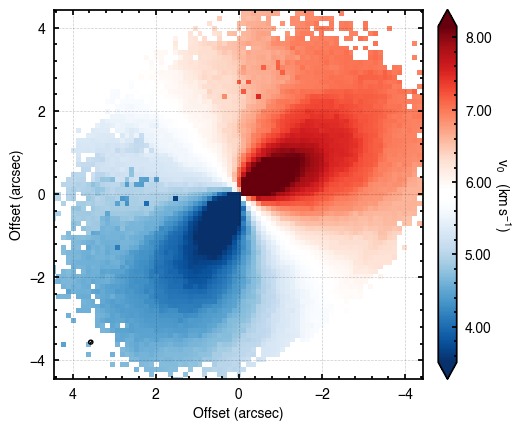
A 2D Fit¶
To begin, we can fit a simple 2D model to the data, just as we did for TW Hya. Note here we have used optimize=False to skip the initial optimization of the free parameters. As you will see, this is because the model is actually a poor description of the data and the current implementation will almost certaintly fail.
[4]:
params = {}
params['x0'] = 0
params['y0'] = 1
params['PA'] = 2
params['mstar'] = 3
params['vlsr'] = 4
p0 = [0.0, 0.0, 312., 2.0, 5.7e3]
params['inc'] = 46.7
params['dist'] = 101.0
samples = cube.fit_map(p0=p0, params=params, optimize=False,
nwalkers=64, nburnin=500, nsteps=500)
Assuming:
p0 = [x0, y0, PA, mstar, vlsr].
100%|███████████████████████████████████████| 1000/1000 [00:20<00:00, 49.34it/s]
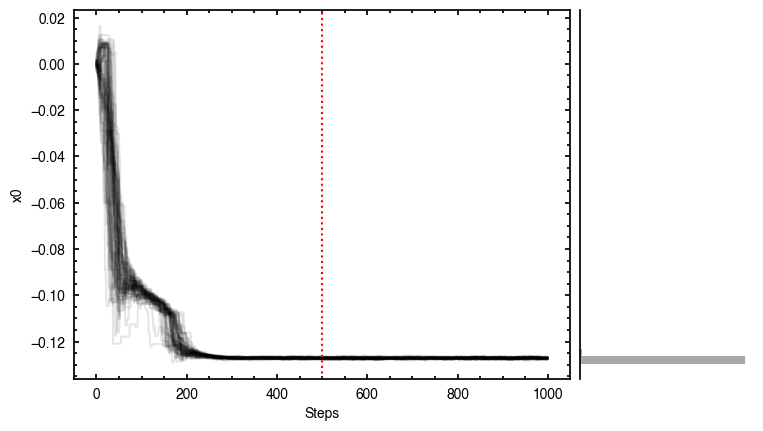
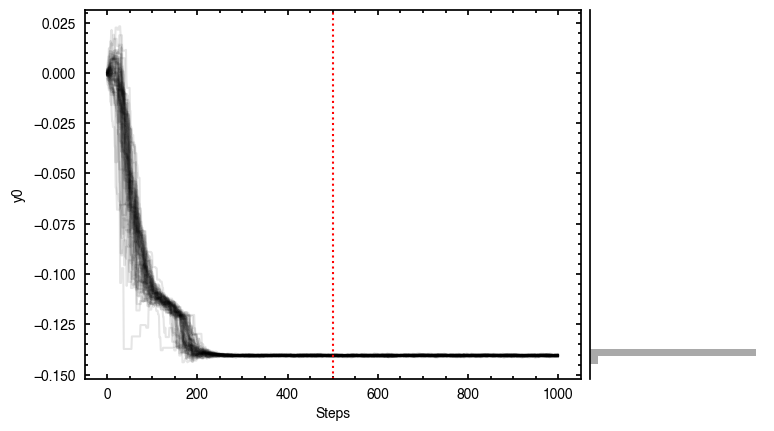

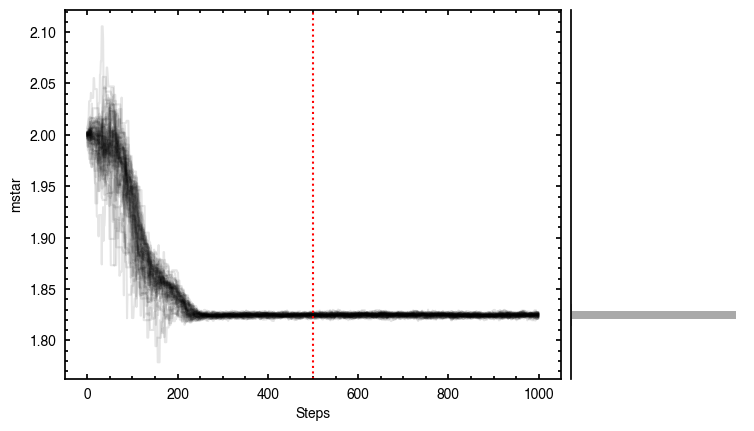
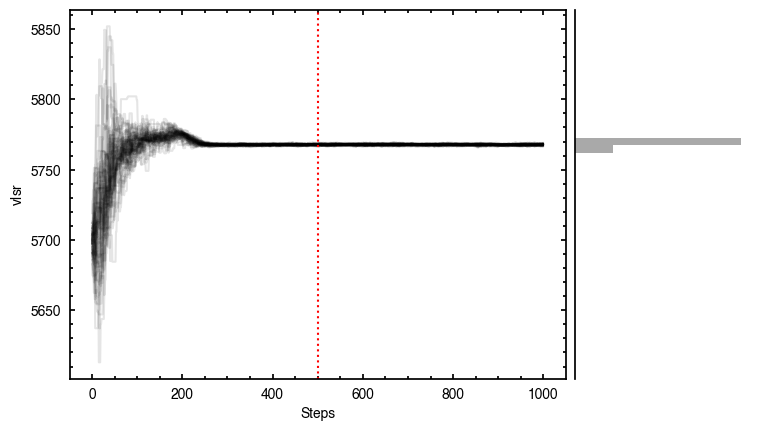
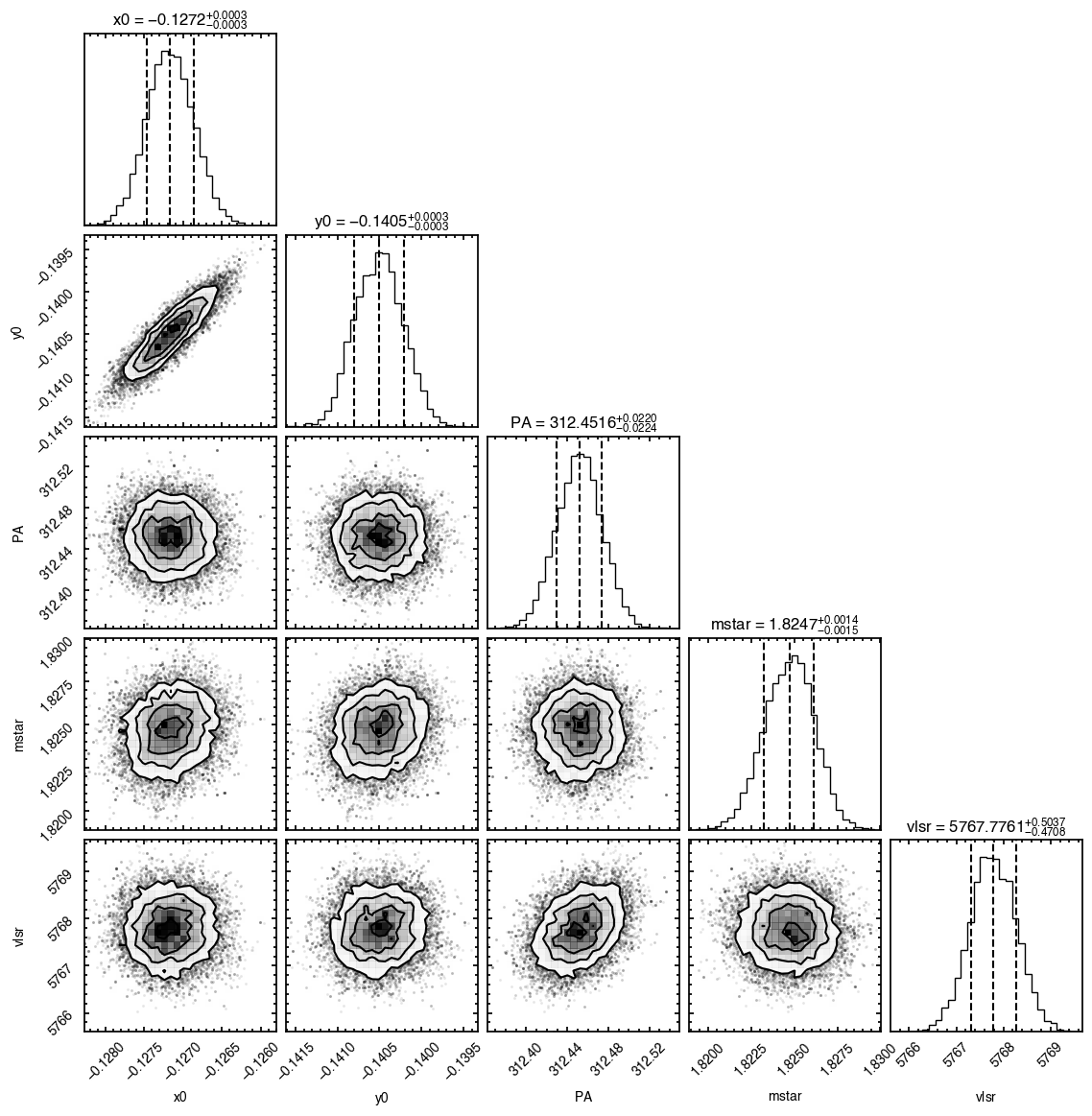
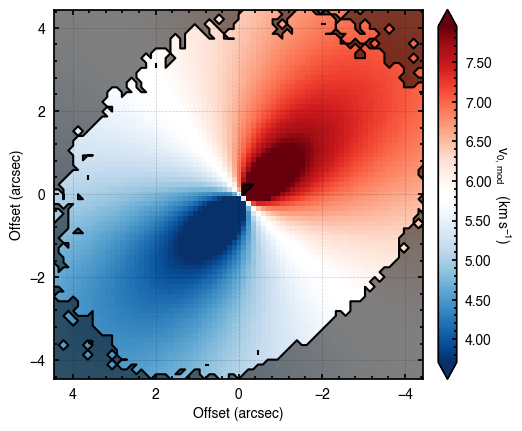
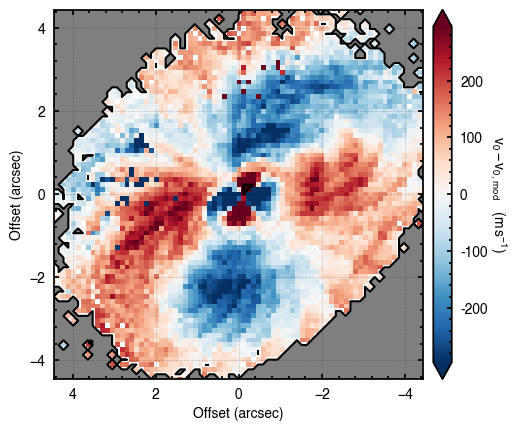
The walkers clearly converge to a best-fit model, but from the residual plot, it is clear this is not a good representation of the data. There are four main residual features we can identify here, and interpret with the help of the Appendices from Teague et al. (2019) and Yen & Gu (2020):
- A quadrupole feature in the inner disk, likely because the model is not centered. Indeed, the posteriors for both
 and
and  have shifted the model center along the minor axis. As we will see later, this is due to the 3D nature of the disk.
have shifted the model center along the minor axis. As we will see later, this is due to the 3D nature of the disk. - A ringed feature with a positive residual along the red-shifted major axis and a negative residual along the blue-shifted side. This is highly suggestive of a ring of faster rotating gas. For HD 163296, this is highly likely to be associated to the surface density perturbations traced by the gas and continuum (Teague et al., 2018).
- A larger quadrupole feature in the outer disk due to a misspecified emission surface. Again, it is clear that a geometrically thin model is not a good description of HD 163296.
- An arc-shaped residual along the North East edge of the disk. This is contamination from the back side of the disk. Here the line emission arises from behind the continuum (the ‘back side’ of the disk), while the model assumes all the emission arises from the front side of the disk. This is a very common residual feature and can be used to determine the absolute geometry of the disk (i.e., in which direction is the disk tilted relative to the observer). Figure 1 from Teague et al. (2018b) demonstrates this geometry.
Revealing the 3D Structure¶
It is obvious from the residuals that a 2D model is a poor fit for HD 163296. In fact, the vertical extent of a disk can be seen in the rotation map as the lobes of the dipole rotation pattern bend away from the disk major axis. This is very clear for the case of HD 163296. We can use the plot_maxima function which will find the line of maximum and minimum velocities along the red-shifted and blue-shifted major axes, respectively.
[5]:
cube.plot_maxima(inc=46.7,PA=312.0, r_max=4.0, smooth=0.3)
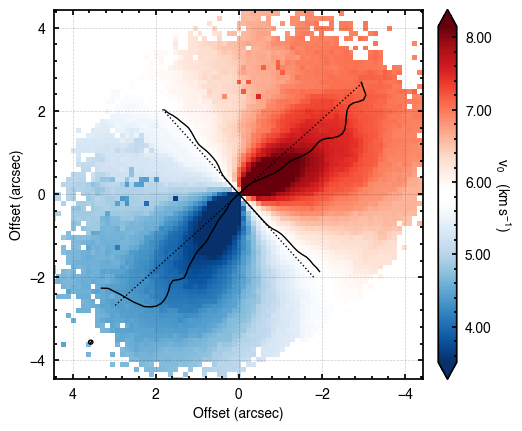
In the above figure, the dotted lines show the major and minor axes of the disk based on the inc and PA values provided. The solid lines show the line of extreme velocities, showing that the emission surface is distinctly elevated. The smooth argument smooths the lines to beat down the jitter due to the noise.
This approach is also good for searching for signs of warps or strong radial flows where there should be a significant variation along the minor axis, as discused in Rosenfeld et al. (2014) or Casassus et al. (2015).
Parameterising the Emission Height¶
We can go beyond the geometrically thin disk approximation and use a more realistic 3D structure. Here we assume an azimuthually symmetric emission surface parameterized by
![z(r) = z_0 \times \left( \frac{r - r_{\rm cavity}}{1^{\prime\prime}}\right)^{\psi} \times \exp \left( -\left[ \frac{r - r_{\rm cavity}}{r_{\rm taper}} \right]^{q_{\rm taper}}\right)](../_images/math/3225434efdce08c4afe5cf7aaf9fad8917f70448.png)
In this parameterization,  is related to the aspect ratio of the emission surface,
is related to the aspect ratio of the emission surface,  describes the flaring of this surface,
describes the flaring of this surface,  allows for an inner cavity, such as in a transition disk, and
allows for an inner cavity, such as in a transition disk, and  descibe an exponential taper to model the drop in emission height at the edge of the disk. With this description we can recover the geometrically thin limit when
descibe an exponential taper to model the drop in emission height at the edge of the disk. With this description we can recover the geometrically thin limit when  and the conical surface discussed in Rosenfeld
et al. (2013) and used with ConeRot with
and the conical surface discussed in Rosenfeld
et al. (2013) and used with ConeRot with  ,
,  and
and  .
.
NOTE: Previous versions of eddy used a double power law described by z1 and phi. The large degeneracy between these parameters strongly favoured a move to this tapered approach (hat tip to Sean Andrews for the suggestion).
The coordinate transforms for geometrically thin disks or conical surface are purely analytical so are very quick. For the more complex surfaces this is a slower process. For monotonically increasing surface with a flaring value close to unity, this can be done in an iterative manner. This is the default in eddy, and the number of iterations used in the deprojection is set by the cube.flared_niter argument, defaulting to 5.
For the more complex surface, particularly those that are not monotonically increasing (i.e., those using the exponential tapered edge), this iterative approach fails (see the GoFish documentation for an example). To circumvent this, eddy also has a slower, but more robust, approach to deprojecting the pixels, invoked with the 'shadowed' parameter. This builds a 3D model of the
emission surface which is then rotated and projected onto the sky.
Rotation Direction¶
Unlike for geometrically thin disks, we can now distinguish the rotation direction of the disk. In eddy, this information is encoded in the sign of the inclination we define. We allow the inclination to run from  to
to  , with negative inclinations representing counter-clockwise rotation and positive inclinations described clockwise rotation. Again, the
, with negative inclinations representing counter-clockwise rotation and positive inclinations described clockwise rotation. Again, the GoFish
documentation has examples to demonstrate this.
One problem of this parameterization is that it is very hard for MCMC methods to jump between negative and positive values of inclination. As such, it is recommended to either fix the inclination, and vary stellar mass, or determine the correct sign of the inclination from the plot_maxima function.
Impact on Velocity Structure¶
The inclusion of a non-zero height will have two affects. Firstly, it will alter the deprojection which will have most significant difference along the semi-minor axis. Secondly, we have to correct  for a) the additional distance to the star from an elevated location (difference in a radial polar coordinate and a radial cylindrical coordinate), and b) the projected gravitational force, resulting in,
for a) the additional distance to the star from an elevated location (difference in a radial polar coordinate and a radial cylindrical coordinate), and b) the projected gravitational force, resulting in,

where  is the cylindrical (or midplane) radius. Note that for the case
is the cylindrical (or midplane) radius. Note that for the case  , this reduced to the same equation used in Tutorial 1.
, this reduced to the same equation used in Tutorial 1.
Fitting a 3D Model¶
With all this in mind, we can try a fit with all these parameters. Note that with the bending of the lobes in the  map towards the bottom right of the image, we can infer that the disk is tilted such that that top left edge is closer to the observer, meaning that the disk is rotating in a clockwise direction. As such, we use a positive inclination.
map towards the bottom right of the image, we can infer that the disk is tilted such that that top left edge is closer to the observer, meaning that the disk is rotating in a clockwise direction. As such, we use a positive inclination.
Because we are almost doubling the number of free parameters, and indeed there’s a covariance between them, we will use a larger number of walkers to help the convergence of the chains. As such, we’re also leveraging the multiprocessing package.
[6]:
params = {}
params['x0'] = 0
params['y0'] = 1
params['PA'] = 2
params['mstar'] = 3
params['vlsr'] = 4
p0 = [0.0, 0.0, 312., 2.0, 5.7e3]
params['inc'] = 46.7
params['dist'] = 101.0
# Include elevated emission surface parameters.
params['z0'] = 5
params['psi'] = 6
params['r_taper'] = 7
params['q_taper'] = 8
params['r_min'] = 2.0 * cube.bmaj
p0 += [0.25, 1.0, 3.0, 2.0]
with Pool() as pool:
samples = cube.fit_map(p0=p0, params=params, optimize=False,
nwalkers=128, nburnin=1000, nsteps=500,
pool=pool)
Assuming:
p0 = [x0, y0, PA, mstar, vlsr, z0, psi, r_taper, q_taper].
100%|███████████████████████████████████████| 1500/1500 [00:47<00:00, 31.43it/s]
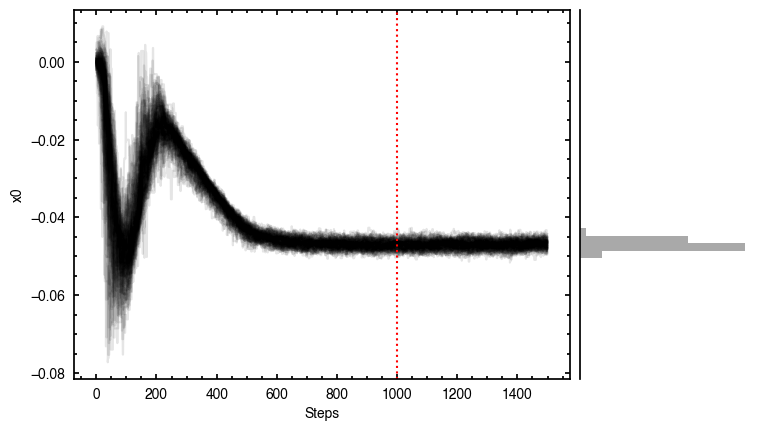
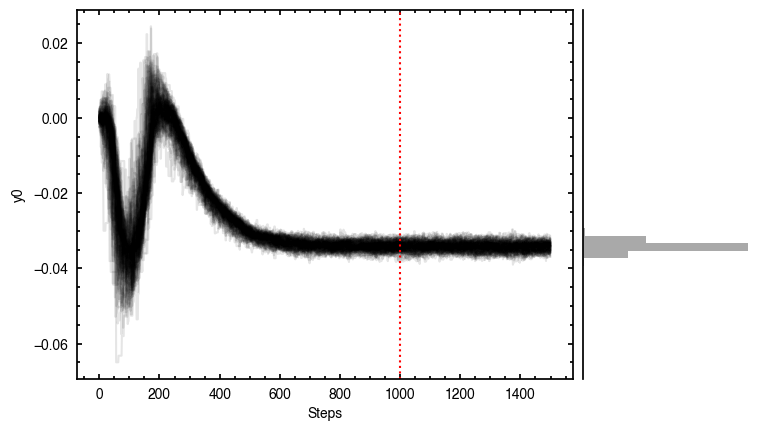

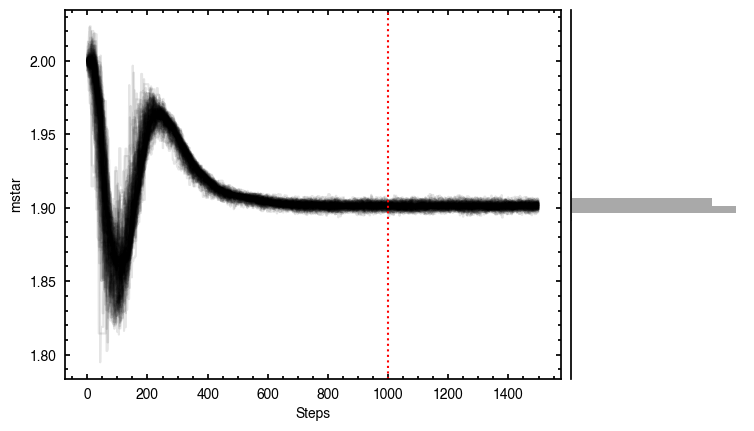
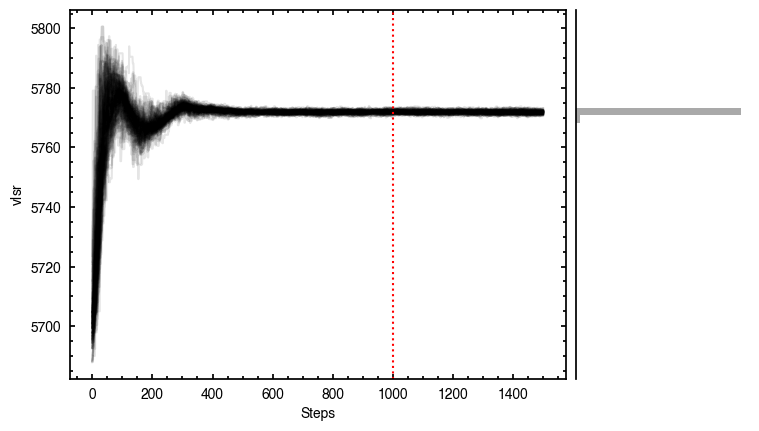


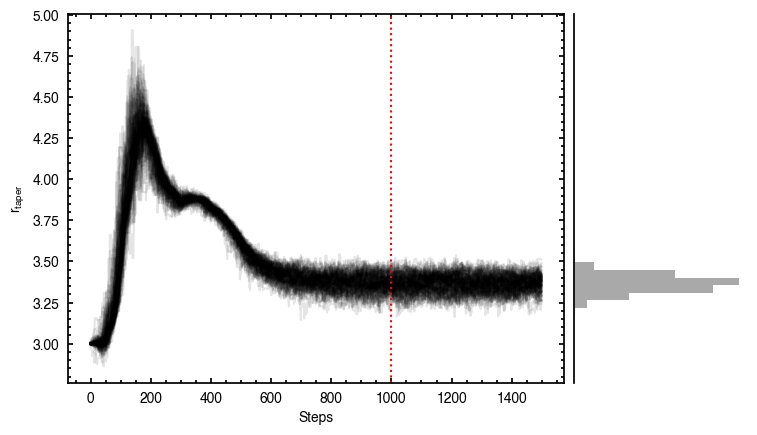
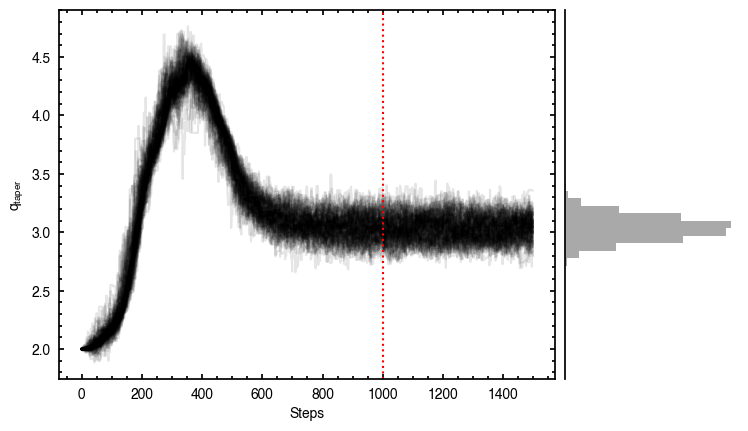

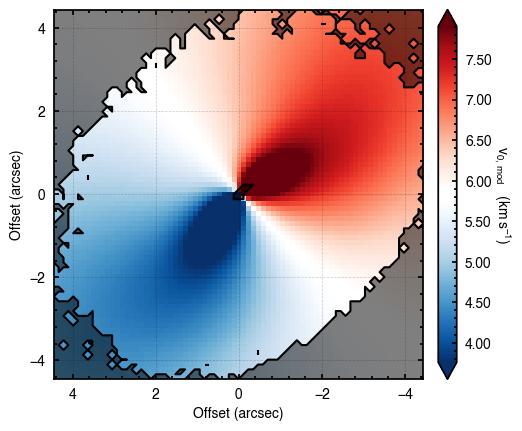
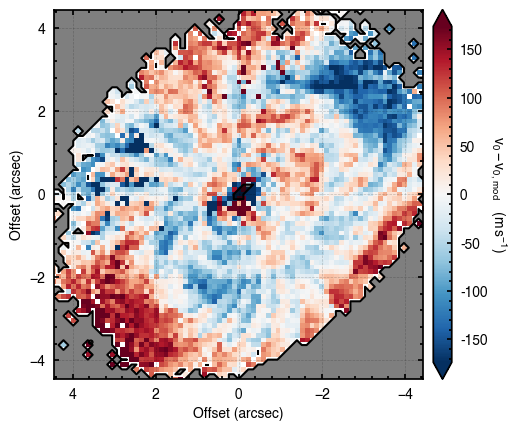
It looks like the chains have converged to a best-fit, and the residuals have definitely improved compared to the 2D fit (the the residuals are  comapred to the
comapred to the  of the 2D fit). We still see the arc-like residual along the North Eastern side, but the quadrupole residuals have been suppressed. Instead, we start to see some ordered substructure associated with the kinematic planetary signature identified by Pinte et al.
(2018) and perturbations in the disk surface density profile (Teague et al., 2018).
of the 2D fit). We still see the arc-like residual along the North Eastern side, but the quadrupole residuals have been suppressed. Instead, we start to see some ordered substructure associated with the kinematic planetary signature identified by Pinte et al.
(2018) and perturbations in the disk surface density profile (Teague et al., 2018).
Interestingly, we do find large positive and negative residuals at the disk edge along the blue-shifted and red-shifted major axes, respectively. This is due to slower rotating gas which Dullemond et al. (2020) argued was due to the large pressure gradienta the outer edge of the disk.
Plotting the Emission Surface¶
Now that we have constrained the emission surface (on the assumption that out model is a reasonable replication of the true source structure), we can overplot the emission surface to check what that looks like. Here we’ve used the imshow_kwargs and plot_surface_kwargs to fill the background with the attached data. The plot_model_surface is a wrapper for plot_surface which is slightly more flexible, but only accepts fixed geometrical properties rather than a (samples,
params) pair.
[7]:
imshow_kwargs = dict(vmin=2.77, vmax=8.77, cmap=cube.cmap())
plot_surface_kwargs = dict(fill='self.data / 1e3',
imshow_kwargs=imshow_kwargs)
fig = cube.plot_model_surface(samples, params, plot_surface_kwargs=plot_surface_kwargs)

Improving the Fit¶
As we have discussed, a major residual we are seeing is due to the back side of the disk. We can use the masking properties to avoid this region in the fit of the data. As we are cutting down the region we are fitting, it is sensible to reload the data and use a tight FOV value.
[8]:
cube = rotationmap(path='HD163296_CO_v0.fits',
downsample=4,
FOV=5.0)
cube.plot_data()
Assuming uncertainties in HD163296_CO_dv0.fits.
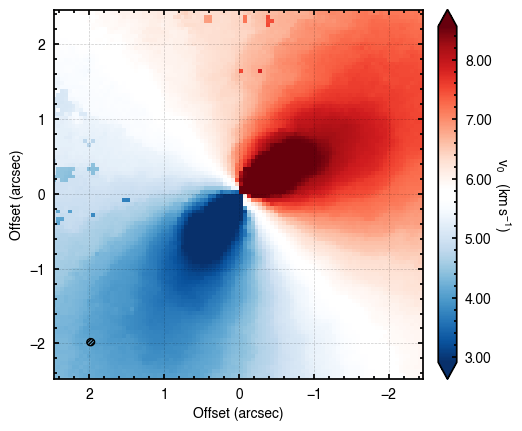
[9]:
params = {}
params['x0'] = 0
params['y0'] = 1
params['PA'] = 2
params['mstar'] = 3
params['vlsr'] = 4
p0 = [0.0, 0.0, 312., 2.0, 5.7e3]
params['inc'] = 46.7
params['dist'] = 101.0
params['z0'] = 5
params['psi'] = 6
params['q_taper'] = 7
p0 += [0.25, 1.0, 2.0]
params['r_taper'] = 2.0
# Include a mask that cuts out the backside emisison.
params['r_min'] = 2.0 * cube.bmaj
params['r_max'] = 2.8
with Pool() as pool:
samples = cube.fit_map(p0=p0, params=params, optimize=False,
nwalkers=128, nburnin=500, nsteps=[100, 1000],
pool=pool, niter=2)
Assuming:
p0 = [x0, y0, PA, mstar, vlsr, z0, psi, q_taper].
100%|█████████████████████████████████████████| 600/600 [00:26<00:00, 22.86it/s]
100%|███████████████████████████████████████| 1500/1500 [01:07<00:00, 22.32it/s]

